If you’ve read my last couple posts, you know that I spent this past weekend at Coffee Fest in Seattle. One of the reasons I wanted to go to the show was to see the city itself. It had been a long time (8 years or so) since I visited the Emerald City, and I had forgotten how much bigger Seattle is. Seattle’s downtown area has a lot more people and quite a bit more traffic.
Like Portland, Seattle has a reputation for being rainy, but when the sun is out (as it was on Friday afternoon), it is a beautiful city. On a clear day you can see the Olympic Mountains to the West and Mount Rainier to the East. Located on Puget Sound, Seattle has a number of inlets and lakes that carve up the city.
 Nothing but blue sky, at least for one day
Nothing but blue sky, at least for one day
Seattle is the most caffeinated city in the US (Portland is #2), probably because the city has a lot of cloudy weather and people need something to help them get through the winter rain. It also could be that northern European settlers who came to work in the timber industry brought their coffee culture with them. Whatever the cause, it is fitting that the world’s largest coffee chain is based here. I didn’t think that a city could have more Starbucks per square mile than downtown Portland (which has at least twenty if you include the licensed stores), but in the ten-block area of Seattle that I walked around in, I saw six or seven Starbucks. If you add the other cafés, there must be an at least three cafés per city block. Wherever you are in the city, you don’t have to walk very far to find coffee.
I arrived at the Washington State Convention Center about 12:30pm on Friday, just after the exhibition started. My first stop was the attendee will-call. Portland Roasting had made my reservation (thanks!) and things went smoothly. The woman quickly found my name and gave me my pass. I picked up a badge holder and a “swag bag” and headed for the exhibition hall.
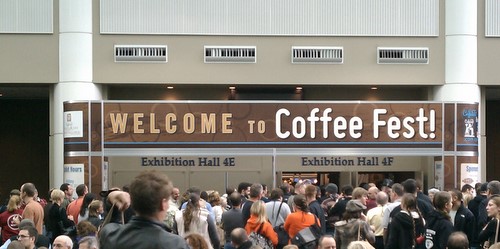 People can't wait to get inside
People can't wait to get inside
My first impression of the exhibition floor was that I could not believe how much stuff was on display. I found that it was like the rest of America. If you want to buy something, someone will sell it to you. I saw green coffee, roasted coffee, coffee roasters, coffee bags, espresso machines, to-go cups, recyclable cups, compostable cups, saucers, stirrer sticks, smoothie mixes of all types of flavors, baked goods, packaged granola bars, biscotti, instant oatmeal, pastries, hot chocolate warmers, ready-made drink mixes, flavor syrups, LED signs, café consulting services, automatic drink machines, labels, label printers, POS systems, water filtration systems, teas, cups, disposable French presses—whew!—everything you could ever need if you were interested in starting a café.
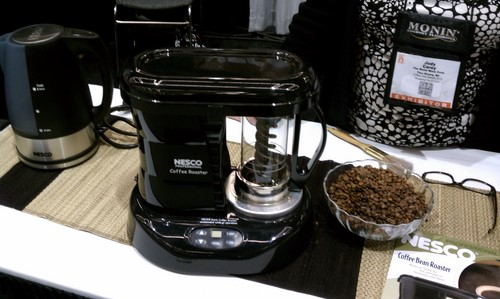 A mini-table top roaster
A mini-table top roaster
Coffee Fest was geared toward independent coffee shops. Smaller local or regional roasters were on display, but the big ones did not have a presence there. The most popular booths were the booths that gave out free samples of drinks and food. Cafés like Caffè Vita, Dillanos, Caffè Umbria, Caffè d’Arte were serving up free espresso drinks and free brewed coffees, so they naturally attracted visitors to their booths. At first, the people seemed to flock to the mini-cafés spread throughout the hall. The food booths increased in popularity over time, as participants got saturated with coffee and looked for other ways to satiate their carvings.
Portland Roasting was well-represented, and its “know your nose” challenge was popular with attendees. Visitors tried to identify ten different scents, among them lemon, wood and rubber. It was more difficult than you might think. At the other end of the booth, Nathanael was grinding and brewing (pour-overs) fresh coffee for passersby. I tried the Kona, which was sweet and honey-like.
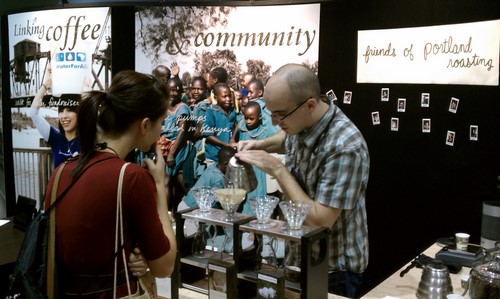 (Good) pour technique
(Good) pour technique
As I walked around enjoying the sights and sounds of the show, I kind of wished that I had my own café so that I could really negotiate with the people at the booth for their products. I was able to talk to them, but once they found out I didn’t have a café, I could tell that several people lost interest in talking to me. I don’t blame them—they were at the show to sell products and I wasn’t planning to buy any. Most were polite, but they were definitely on the lookout for the next potential customer. When those customers arrived, I moved on.
Some, however, heard that I wrote about coffee and said, “Hey! Come on over and write about us—We’d love to tell our story!” Such was the case when I stopped at the Kiss My Bean booth. Kiss My Bean is a company based in Colorado that sells greeting cards and other merchandise, products that are good for point-of-sale displays. The cards are geared toward coffee lovers and coffee bean art and puns on them. For example, “Have a bean-u-tiful day!” or “We bean-long together” are on two of their cards. All of the drawings have images of coffee beans incorporated into them.
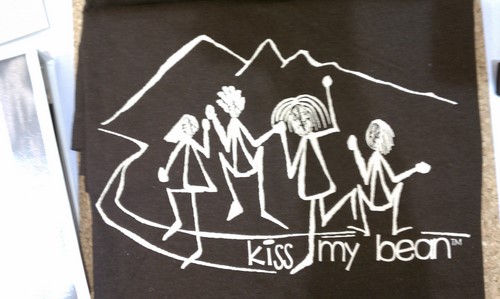 I've bean trying to think of a clever pun of my own, to no avail. . .
I've bean trying to think of a clever pun of my own, to no avail. . .
According to the company website, Kiss my Bean “is made up of three old wacky women and one young one who keeps us in line.” I got to talk for a while with Pat and Linda, two of the ‘old wacky women.’ They told me that they donate 25 cents from the sale of each card to Café Femenino, a non-profit that helps women coffee producers in rural communities around the world. Kiss My Bean is doing more than just trying to make a profit—it is trying to make a difference too.
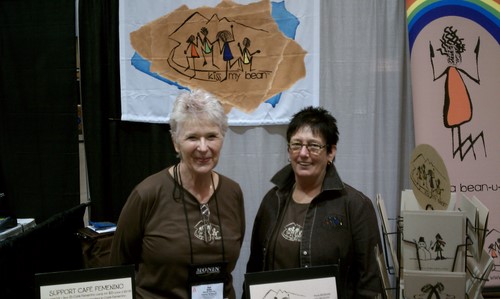 Pat and Linda, two of the head beans
Pat and Linda, two of the head beans
In many ways, I wished that I could have been working the trade show. I would have particularly liked to spend some time working for the Italian coffee company Caffè Carraro. Carraro is trying to enter the US market for the first time, and I sensed that they were having a difficult time reaching out to people. It seemed to me that this was partly due to the language barrier. I know how hard it can be to try to communicate in languages other than my native tongue, and I would have liked the opportunity to be their ambassador. Therefore, Davide, Giulio and Valeria, if you need someone to work the Chicago Coffee Fest in February, send me an email. I’d be happy to come and help. I have a soft spot in my heart for espresso italiano (Italy is where I learned to drink coffee) and I know I could attract more people to your booth (You could pay me back with three days of Italian language tutoring).
 You can tell the quality with your eyes closed
You can tell the quality with your eyes closed
(Part Two here)